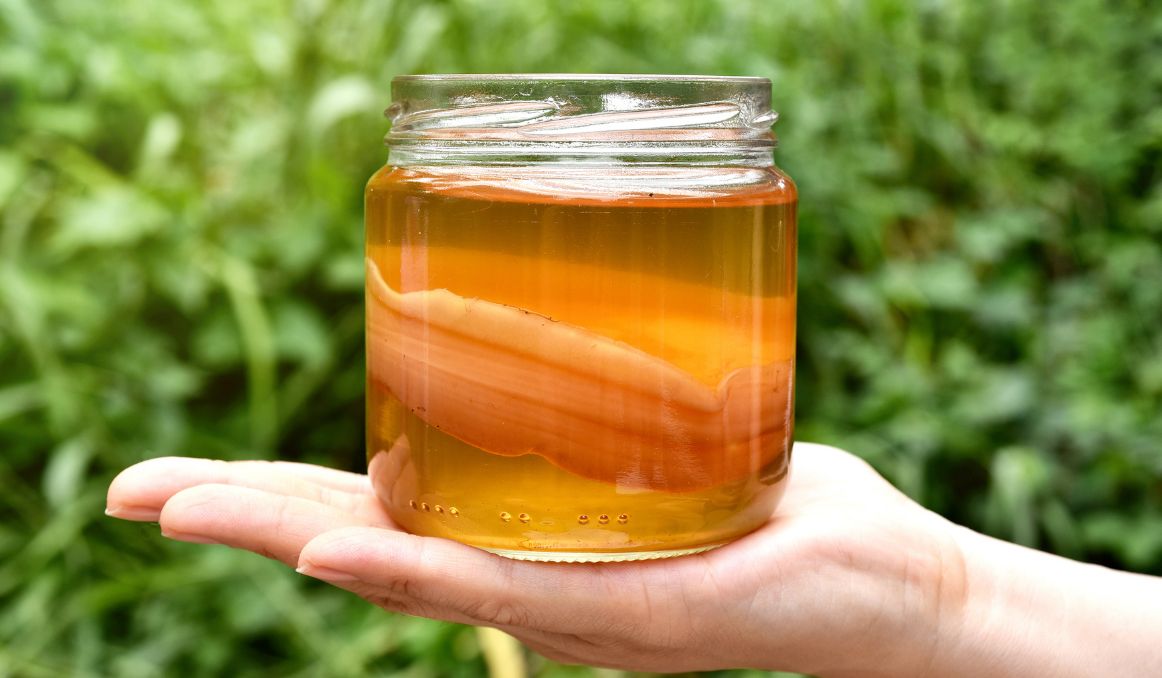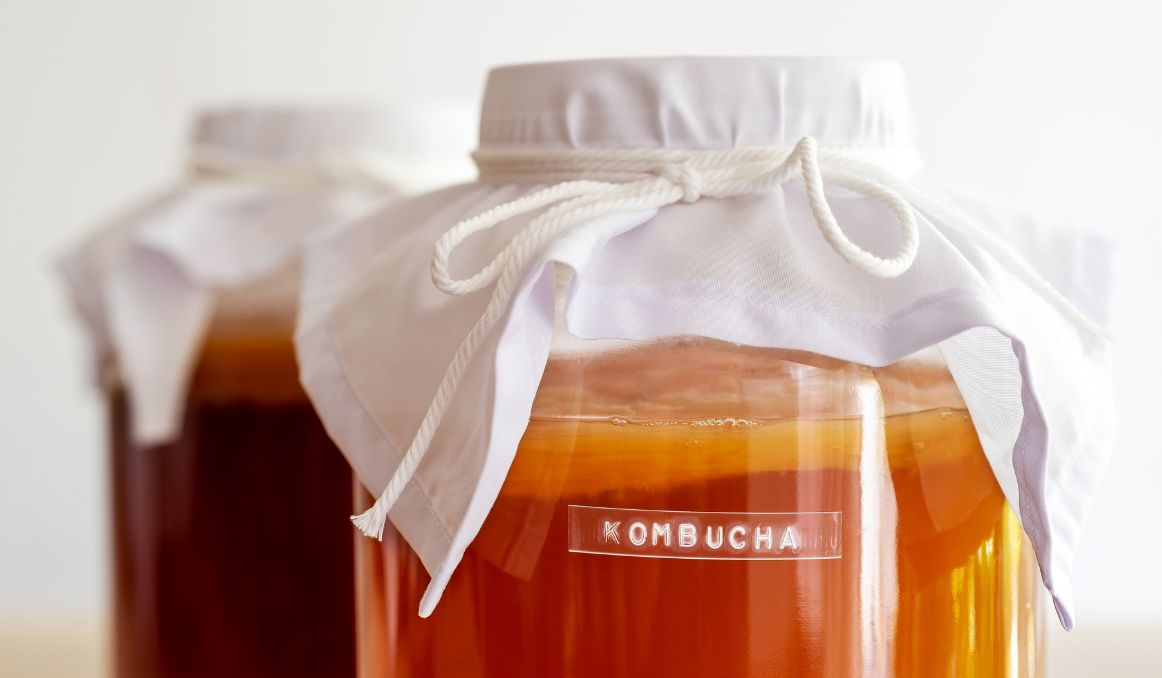Does Kombucha Need Air to Ferment? Your Need to Know
Kombucha has arguably been around for at least as long as beer and wine, if not longer. It has traveled oceans and civilizations. But it is fairly new to many people in the western world.
So, what is it? What sets it apart from other brews? How does it ferment? And does kombucha need air to ferment?
Kombucha

While the exact origins and history of kombucha are unclear, the drink is thought to have originated in China and traveled to the western world via the silk trade roads.
In its original state, kombucha is merely fermented tea.
Black or green tea is brewed and then sugared. Once it has cooled, a combination of yeast and bacteria is added, often referred to as SCOBY, or symbiotic culture of bacteria and yeast.
SCOBY gets to work fermenting the tea, converting all the sugar to alcohol and carbon dioxide, while also producing a probiotic drink that is often considered to be quite beneficial to human health.
Today, you will find a wide variety of kombucha flavors on the shelf with additional ingredients that include everything from cranberry or pomegranate to ginger and carrot.
Does Kombucha Need Air to Ferment?
The general consensus is that SCOBY needs air to ferment as air and sugar are what keep yeast and bacteria alive.
In many fermentation tanks, a tube to release carbon dioxide pressure is attached while the tank is kept airtight to prevent unwanted bacteria and yeast from getting into the brew.
It is critical to keep in mind, however, that the air already in existence in the tank can still contribute to the fermentation process in drinks like beer and wine.
There are some strains of yeast and bacteria that can continue to ferment without air.
However, most of those strains are not the ones used in kombucha.
With kombucha, you will have to ensure a regular oxygen flow. Without ventilation, your kombucha won’t ferment.
Alcohol Kills Bad Bacteria
A much more important question than whether kombucha needs air to ferment is whether brewers really need to worry about it.
The answer to that question is probably not.
Just like with beer and wine, the yeast and bacteria in SCOBY, along with the alcohol that is produced by SCOBY work very hard to fight off any harmful bacteria from contaminating the kombucha.
This is, of course, not to say that it does not happen or to say not to take necessary cleanliness and sanitation measures, but it is to say that contamination is not a big enough problem to worry too much about keeping an airtight container.
Any off flavors in your kombucha will alert you right away to any flavor or aroma problems you may have encountered in the fermentation process.
Probiotics, You Say?
Yes. Probiotics.
The big selling point for kombucha is its probiotic qualities.
Lately, there has been much talk in the scientific community about probiotics and their connection to gut health.
Apparently, all health problems can be related back to the health of your gut, or your microbiome.
According to the health department at UC Davis,
“A healthy gut contains healthy bacteria and immune cells that ward off infectious agents like bacteria, viruses, and fungi. A healthy gut also communicates with the brain through nerves and hormones, which helps maintain general health and well-being.”
So yes, a healthy gut is critical to your overall health.
And probiotics play an important role in your gut health.
Probiotics are live bacteria and yeasts that are good for you, especially your digestive system.
The primary probiotic we think of as good for us is Lactobacillus, the good bacteria we find in yogurt and other fermented foods.
Health Benefits of Kombucha and Probiotics
Aside from feeding your gut and making it healthy, probiotics and kombucha are also reported to be good for you in many other ways.
- Help aid digestion;
- Rid your body of toxins.
- Boost your energy;
- Ward off high blood pressure;
- Stave off heart disease.
May help prevent cancer
While kombucha is still awaiting more good quality, robust studies, many of the compounds it contains have been studied extensively, so it’s not a stretch to draw the conclusion that kombucha has many of the same health benefits.
Good Kombucha Recipe

Now, you know the health benefits of kombucha, and you can certainly head to pretty much any market these days and pick up a bottle or two, but since you’re here, and you already have so much information on hand, you might as well try your hand at making your own kombucha, right?
If it can be brewed and fermented, it can be brewed and fermented at home.
And why not try it?
This way, you’ll know exactly what ingredients go into your home batch, and exactly where those ingredients were sourced.
Talk about farm to table.
Tips for Kombucha:
- Keep your container glass. Metal can react with the acid in kombucha and plastic can harbor nasty bacteria.
- Clean and sanitize everything to avoid unwanted (bad) bacteria and yeast.
- Keep an eye out for mold. If you notice anything green, white, or black on your fermenting tea, toss the batch. Better that than to get sick.
SCOBY
To make your SCOBY, which is the primary fermenter in your tea, you will need to combine
- 7 cups of water
- ½ cup of white sugar
- 4 bags of black tea
- 1 cup of unflavored, already prepared kombucha
Boil your water, add your tea and sugar and allow to steep.
Once it cools, pour your tea into your glass container(s) and then add your kombucha.
Cover with cheesecloth and create a tight fitting so no bugs or debris can get in.
Sit your container somewhere dark and at room temperature, about 70 degrees Fahrenheit.
After a couple weeks, you will notice a ¼ inch thick film at the top of your container. That’s your SCOBY. Toss the rest of the tea as it is far too vinegary to be enjoyable.
Now, to make your kombucha, combine
- 14 cups of water
- 1 cup of white sugar
- 8 bags of black or green tea
- 2 cups of unflavored kombucha
- Your SCOBY
Boil your water, add your sugar and tea, and allow to steep and cool.
Add your SCOBY with clean hands.
Pour your tea into your glass container and add your starter kombucha.
Set the container somewhere dark and room temperature, covered with your tight fitting cheesecloth, and wait about 10 days.
Your kombucha will be mildly sweet and slightly vinegary.
Cheers!
Passionate about yeast fermentation and all the wonders it can do? So are we! If you’re interested in finding out how you can use our technology to control fermentation and monitor your yeast, save work hours and improve the cost-efficiency of your business, drop us a line at [email protected]
Also, check out these product pages, if you’re into beer or wine making:
- Oculyze BB 2.0 (Better Brewing) Yeast Cell Counter App + Hardware
- Oculyze FW (Fermentation Wine) Yeast Cell Counter App + Hardware
…or our custom solution page for other use cases (yours included):
Sources:
- C. J. GREENWALT, K. H. STEINKRAUS, R. A. LEDFORD, Kombucha, the Fermented Tea: Microbiology, Composition, and Claimed Health Effects, J Food Prot (2000) 63 (7): 976–981
- https://www.scientificamerican.com/video/what-is-kombucha/
- https://www.bonappetit.com/test-kitchen/common-mistakes/article/kombucha-common-mistakes
- https://health.ucdavis.edu/news/headlines/what-is-gut-health-and-why-is-it-important/2019/07


